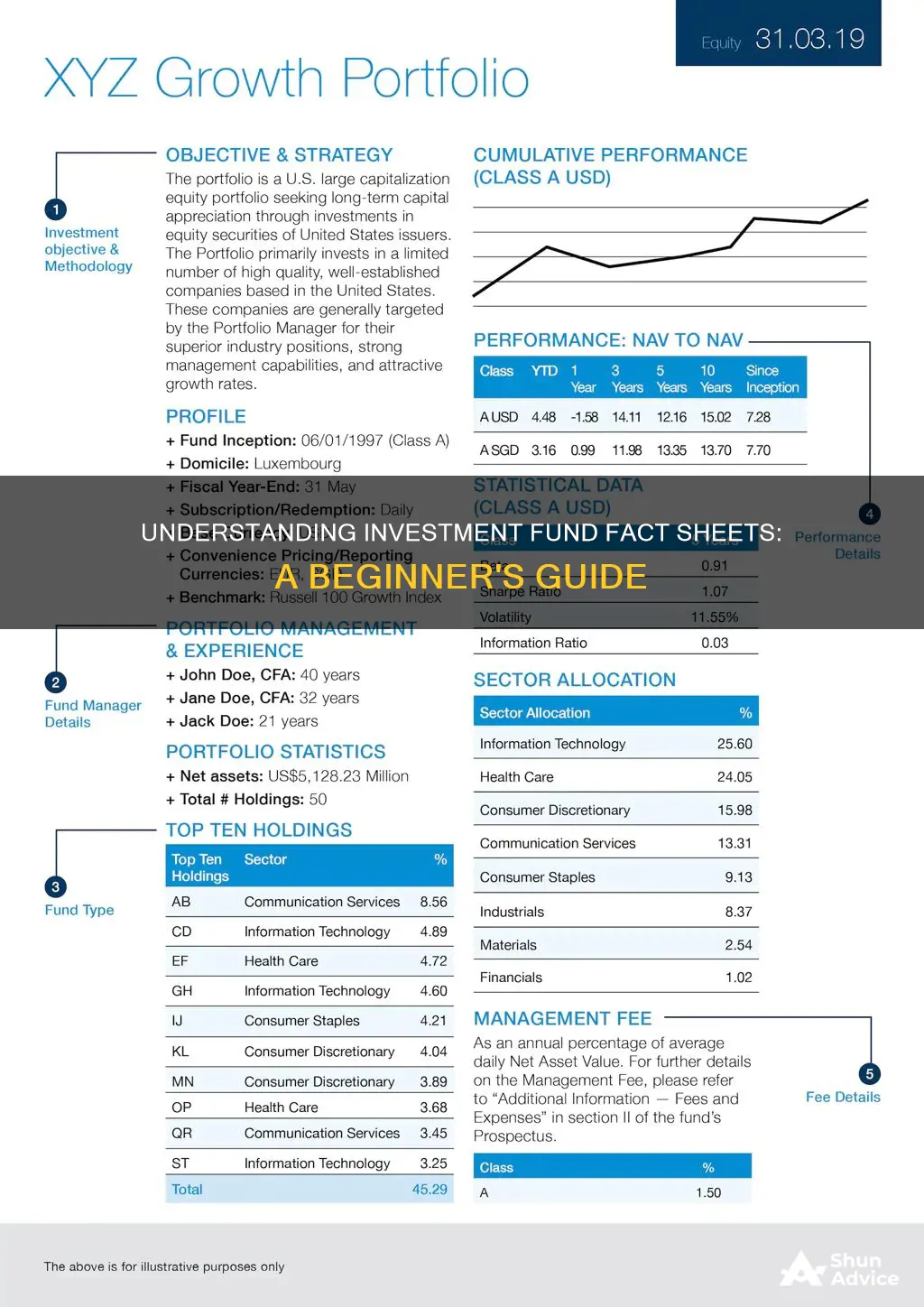
Investment fund fact sheets can be daunting, packed with facts and figures that are difficult to decipher. However, they are important documents that provide a summary of all the key information about the fund you've invested your money in. They can tell you about the fund's performance, its portfolio, fees, and risk profile. By reading a fund fact sheet, you can understand exactly what you've put your money into and make more informed investment decisions. In this article, we will break down the different components of an investment fund fact sheet, so you know what to focus on and how to make the most of this valuable resource.
| Characteristics | Values |
|---|---|
| Purpose | To provide a summary of a fund's key information |
| Information | Fund name, fund manager, fees, fund performance, fund holdings, risk rating, investment mix, fund value, fund manager contact details |
| Benefits | Easy to find, accessible tool for investors to stay informed about a fund's essentials |

Investment objectives
The investment objective section outlines the fund manager's primary goals and strategies for generating returns. This section will typically describe whether the fund aims for capital appreciation, income generation, or a balance of both. For example, a fund objective might state, "Fund X seeks to track the performance of the index and invest in large and mid-cap company shares in developed and emerging markets." Understanding the investment objective is essential to ensure it aligns with your financial goals and risk tolerance.
Geographical Focus and Market Regions
Investment Strategies and Types
This section should provide insights into the types of investments the fund focuses on. It might include information about the size of companies the fund invests in, such as large-cap, mid-cap, or a mix. Additionally, it may mention the use of derivatives, collective investment schemes, or other financial instruments as part of its strategy. Understanding the investment types and strategies helps you gauge the potential risks and returns associated with the fund's approach.
Targeting Capital Gains or Income
Fund fact sheets often clarify whether the investment objective is focused on targeting capital gains or generating income. Capital gains refer to profits realised from the sale of investments, while income refers to dividends or interest earned from the investments. Some funds may have a dual focus, aiming for both capital appreciation and income generation. This information is crucial for understanding how the fund aims to deliver returns to investors.
Benchmarks and Performance Measurement
Risk Tolerance and Volatility
While not always explicitly mentioned in the investment objectives section, risk tolerance and volatility are crucial factors to consider. Fund fact sheets often provide a risk rating or volatility measure to indicate the potential for the fund's value to fluctuate over time. This information is essential for determining if the fund aligns with your risk tolerance and investment horizon. Remember that higher volatility indicates greater potential for gains but also carries a higher risk of losses.
Time Horizons and Long-Term Goals
Although not always explicitly stated, the investment objectives may imply the fund's intended time horizon. Some funds may have a short-term focus, aiming for rapid gains, while others may take a longer-term approach, seeking steady growth over an extended period. Understanding the fund's time horizon is crucial for aligning it with your financial goals and ensuring it matches your investment timeline.
In summary, the investment objectives section of a fund fact sheet provides critical insights into the fund manager's strategy, geographical focus, investment types, risk tolerance, and potential returns. This information empowers investors to make informed decisions by evaluating how well the fund aligns with their financial goals, risk tolerance, and investment horizons. Remember to consider all aspects of the investment objectives to make a comprehensive assessment before making any investment decisions.
Appaloosa Hedge Fund: A Guide to Investing Wisely
You may want to see also

Fund performance
Performance data is typically presented in full calendar years or quarterly increments for the most recent year, with data going back to the fund's inception or at least 10 years. This long-term perspective helps investors evaluate the fund's performance in different market environments.
When reviewing fund performance, investors can compare the fund's returns against relevant benchmark indices, such as the S&P 500 or FTSE All-Share Index, to understand how well the fund is doing relative to its peers or the broader market. This comparison provides context and helps investors identify top-performing funds.
Fact sheets may also include the fund's annualised returns over longer periods, such as 10 years, which takes into account both income and capital gains. Additionally, quarterly returns may be provided, as fund managers often focus on quarterly performance.
It is important to remember that past performance does not guarantee future results, but it can give investors an idea of the fund's consistency and whether it aligns with their investment goals and risk tolerance.
Some key performance indicators to look for include:
- Standard Deviation (SD): Measures the volatility of the fund's returns compared to its mean or average. A lower SD indicates lower risk.
- Beta: Indicates the fund's volatility relative to a benchmark index. A beta of 1.2 means the fund is 20% more volatile than the benchmark. Lower beta denotes lower risk.
- Sharpe Ratio: Compares the fund's risk-adjusted performance by evaluating the overperformance of a security relative to a risk-free return, in relation to the volatility of that overperformance. A higher Sharpe Ratio indicates better risk-adjusted returns and is useful for comparing funds with similar returns.
Hedging Mutual Fund Investments: Strategies for Risk Mitigation
You may want to see also

Risk assessment
- Risk Rating: The risk rating of a fund is typically expressed as low, medium, or high. This gives investors a general idea of the level of risk they are taking on. It's important to note that higher-risk investments often lead to higher returns but come with a greater possibility of loss.
- Volatility: Volatility measures the fund's price fluctuations over time. It is usually presented as a standard deviation or a similar metric. Higher volatility indicates that the fund's value can change rapidly, while lower volatility suggests a more stable investment.
- Risk Metrics: Look for specific risk metrics or assessments provided by the fund. These may include measures such as the fund's historical volatility, value at risk (VaR), or other proprietary risk ratings. These metrics give a more detailed view of the fund's risk characteristics.
- Risk Factors: The fact sheet should also outline specific risk factors relevant to the fund. For example, it might mention investment risk, currency risk, or other types of risks associated with the fund's strategy or holdings. Understanding these risks is crucial for making an informed decision.
- Risk Disclosure: Pay attention to any risk disclosures or warnings included in the fact sheet. These statements typically highlight that past performance does not guarantee future results and that investors could lose money. It's important to be aware of these potential risks before investing.
- Risk Mitigation: In some cases, the fact sheet may also discuss how the fund manages or mitigates risks. This could include diversification strategies, risk management techniques, or other methods employed by the fund managers to balance risk and return.
- Comparison to Benchmark: To evaluate the fund's risk-adjusted performance, compare its returns to those of a relevant benchmark index. This helps assess whether the fund's risk is justified by its performance relative to similar investments.
- Historical Performance: While past performance doesn't predict future results, analysing historical returns can provide context for the fund's risk profile. Look at how the fund has performed during different market conditions, such as bull and bear markets, to gauge its behaviour in varying risk environments.
- Risk vs. Return: Consider the balance between risk and return offered by the fund. Assess whether the potential returns align with your risk tolerance and investment goals. Remember that higher returns often come with higher risk, so ensure you are comfortable with the level of risk before investing.
- Risk Tolerance: Evaluate the fund's risk in the context of your own risk tolerance. Different investors have varying capacities for taking on risk. Consider your financial goals, time horizon, and personal comfort level when assessing whether the fund's risk level aligns with your investment strategy.
By carefully reviewing the risk assessment section of an investment fund fact sheet, investors can gain a deeper understanding of the potential risks associated with the fund. This information is crucial for making informed investment decisions and ensuring that the fund aligns with their risk tolerance and financial objectives.
Covered Funds: A Smart Investment Strategy?
You may want to see also

Fees and expenses
- Types of Fees: Funds typically charge a fee based on a percentage of your investment. However, there may be additional fees, such as higher fees for better fund performance or initiation fees. It is important to understand whether these fees include or exclude taxes and if there are any penalty-type fees.
- Total Expense Ratio (TER): This is the average of actual expenses over a year, expressed as a percentage of your investment. For example, a TER of 1.78% on an investment of R100,000 would result in annual costs of R1,780.
- Comparison to Similar Funds: Compare the fees of different funds offering similar investment portfolios. This will help you assess if the fees are reasonable and if there are any significant differences.
- Impact on Returns: High fees can significantly impact your overall investment returns. Even small differences in fees can add up over time and reduce your profits.
- Transaction Costs: In addition to the stated fees, consider the transaction costs associated with the fund. These costs can be significant and are often not included in the fund fact sheet.
- Frequency of Fee Assessment: Find out how often the fees are assessed and charged. Is it a one-time fee, an annual fee, or something else? This will help you calculate the total cost of investing in the fund.
- Advisor Fees: Don't forget to factor in the fees charged by your financial advisor or wealth manager. These fees can add up and impact your overall returns.
ETFs: A Smart Investment Strategy for Your Money
You may want to see also

Fund managers
Investment fund fact sheets are a great way for fund managers to communicate the key information about the fund to investors. They are a summary document that gives an overview of the fund's purpose, risk, details, and past performance. Here are some key things to include and look out for in a fund fact sheet:
Fund Name and Objective
The fund name typically includes the fund manager, the index provider, and the geographic region or market covered. The objective states what the fund aims to achieve, such as tracking the performance of an index or investing in specific types of companies or assets.
Investment Term and Risk
The investment term should be clearly stated, indicating whether the fund is for short, medium, or long-term investment. This is important as it is related to the potential loss of capital. The risk factor or risk rating should also be included, giving investors an idea of how risky the fund is and the potential for the fund to fluctuate in value.
Fees and Costs
Details on fees and costs are crucial for investors to understand the impact on their returns. Most funds charge a fee as a percentage of the investment, and there may be additional costs such as transaction fees or penalty fees. The Total Expense Ratio (TER) or Ongoing Charge Figure (OCF) represents the average expenses over a year and is an important metric for investors to consider.
Performance
The performance section should include historical data on how the fund has done over various time frames, such as one, three, five, or ten years. This allows investors to assess how the fund has performed against its benchmark or similar funds. It is important to note that past performance does not guarantee future results.
Fund Holdings and Diversification
Information on the underlying funds, company portfolio, or assets that the fund invests in is essential. This gives investors an understanding of the specific investments held by the fund. It is also important to disclose the diversification of the fund, including the number of stocks held, sector weightings, geographic breakdown, and market capitalisation.
Fund Management
The fund fact sheet should include information on the fund managers, including their names, prior experience, and track record in managing the fund. This allows investors to assess the qualifications and expertise of the people managing their money.
By including these key elements in a fund fact sheet, fund managers can provide transparent and valuable information to investors, helping them make informed decisions about their investments.
Passive Fund Inefficiencies: How to Invest and Profit
You may want to see also
Frequently asked questions
A fund fact sheet is a summary document that tells you all the key information about the fund you’ve invested your money in. It will usually include the name of the fund, the fund manager, the fund's performance over the years, and the fund's fees and expenses.
The fund's performance section will include information on how the fund has performed over a certain period. This will typically include the fund's year-by-year returns for the last 10 years or, if the fund is newer, its performance from the date it was created. It may also include the fund's best and worst returns over a three-month period.
The fund's fees and expenses section will include information on the fund's management expense ratio (MER) and its trading expense ratio (TER). The MER is a combination of the fund's management fee and its operating expenses, while the TER is a measure of the fund's trading costs.
A fund fact sheet will also typically include "quick facts" about the fund's value as of a particular date, the fund manager, the required minimum investment, and other relevant details such as contact information and tax implications.
It is generally recommended that you review your fund's fact sheet at least once a year to stay informed about any changes in its strategy, performance, and fees.







